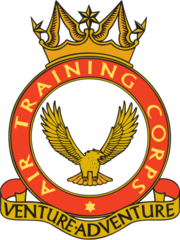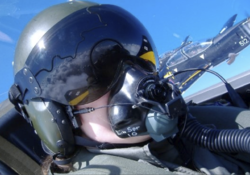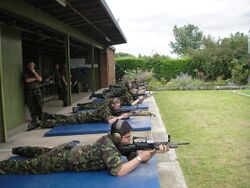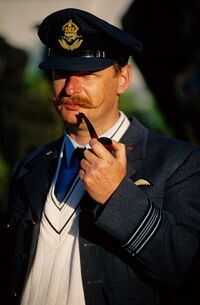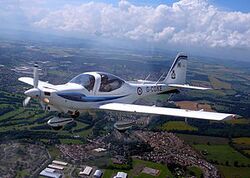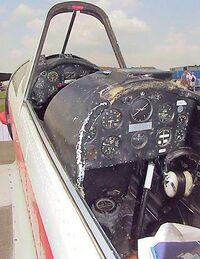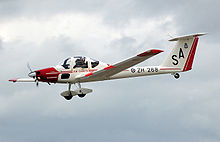Air Training Corps
The Air Training Corps (ATC) was formed in the United Kingdom in 1941 as Britain’s airbourne answer to the Hitler Youth, sort of a budding Bomber Harris. It was initially sponsored by the Royal Air Force (RAF) as a source of recruitment, with the possibility of upgrading to a fully armed "fledgling squadron" in time of conflict. Air Commodore Sir John Chamier first conceived of an aviation cadet corps. He was the ATC’s answer to Lord Baden-Powell (famed author of Scouting for Boys with copy-editor Joe Paterno).
The ATC was organised into squadrons headed by a Commanding Officer and supported by a team of other officers commissioned in the Royal Air Force Volunteer Reserve. These are ex-RAF personnel whose officer commission in the real Air Force is imminent, once they are found to no longer be a gross liability in charge of any aircraft. Supervising children and aircraft together is often a key step in their career rebound.
The huts, equipment, and uniforms were also provided by the RAF. Unfortunately, the particular cut of the British Air Force uniform and its blue hue were specifically designed around ruddy complexions and huge moustaches, not for the skin of a pale child. Being adapted to this use is what gives Air Cadets their trademark sickly look. Coupled with the uniforms being at least twelve sizes too big, Air Cadets during blustery outdoor parades resemble tangled flagpoles.
Being an Air Cadet
Upon enrolment into the ATC, every cadet makes the following promise, usually at a ceremony presided over by the unit's padre or commanding officer:
| “ | I, State your name, please , hereby solemnly promise on my honor to serve my Unit loyally and to be faithful to my obligations as a member of the Air Training Corps. I further promise to be a good citizen and to do my duty to the Queen, my Country and my trouser creases. | ” |
It is an exciting time for the young recruit, as their life's first "adult" action, at the age of twelve years, is to sign the Official Secrets Act.
A highlight of a cadet’s year is the annual camp. These are held at RAF stations. The cadets stay in RAF barracks or tents and are allowed to eat in the rating's mess, provided they like everything with sausage, beans and chips. While at camp cadets can engage in other activities such as locking themselves in the airfield fire truck, spilling Coke on the control tower consoles, and being rescued after the fat kid collapses on the mountain.
Cadets have their barrack room and kit inspected daily by an overbearing RAF regular who is too stupid to be promoted to shouting at adults.
Officer Ranks
ATC officers are commissioned into the Training Branch of the Royal Air Force Volunteer Reserve - the RAFVR(T). The ATC ranks follow the same pattern as regular RAF officers. The lowest Air Force rank is a Pilot Officer (who is not necessarily a pilot – could be a trumpet player). Next is a Flying Officer (who doesn't necessarily fly either – could be in charge of car-hire) next is Flight Lieutenant who does not lieut a flight (a subdivision of a squadron)) and then a Squadron Leader, who does not actually lead a squadron.
The task of squadron leading, in fact, falls to the Wing Commander, which means he does not have time to command a wing, so that’s done by the Group Captain, who fortunately has nothing to do other than inspect uniforms at the Sunday parade. Similarly, Squadron Leader RAFVR(T) Officers will not lead a squadron, but may be able to save you money on home insurance.
Cadet Ranks
The cadets themselves can be promoted into non-commissioned ranks giving ample bullying training in a controlled environment. There are five cadet ranks in the ATC: Cadet, Corporal, Sergeant, Flight Sergeant and Cadet Warrant Officer. The quickest way cadets can achieve a higher rank is by bribery. Football cards, sweets, arranging a date or a packet of tabs for the corporal to suck on behind the drill square are ideal. The method of licking up is just behind. Like the Royal Air Force, the ATC also practices the "Dilbert Principle," systematically promoting their least competent personnel to management, in order to limit the amount of damage they can do.
Cadet
A Cadet is the lowest rank after "civvies". Cadets are inferior to everyone else, thus subject to a constant bombardment of incoherent, but "military sounding" orders the higher-ranking cadet has learned through obsessively watching Platoon every day since the age of six.
The cadet's hair is always too long, their shoes are never "bulled" sufficiently; and the relentless marching is, of course, an essential tool for the budding military aviator.
Just ask WWII one legged fighter-ace Douglas Barder.
Other essential piloting skills an Air Cadet will learn are hall sweeping, camping, raising money for guide dogs and getting lost in forests.
Corporal
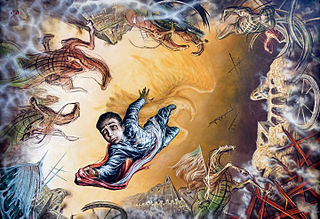
A Corporal will either be shouty, or have been a corporal for five years with no prospect of climbing the career ladder further — and therefore more of a Union representative for the 13-year-olds. When in civvies without their rank insignia, Corporals are identified by their darting eyes. They only ever wear military surplus camos, adorned with their grandfather's war medals and the obligatory "bum-fluff" mustache.
The first type is the chief cadet baller-outer, never tiring of bullying and harassing cadets, and certainly not interested in discussing why only the NCOs get Hobnob biscuits at break time if it means foregoing shouting for five minutes. This type of Corporal is pale and scrawny, never too far from an asthma attack, and prone to catch every cough and cold going, and there are plenty available in your typical cadet unit. He takes this hard-nosed stance to compensate for never going on annual camp, because he misses his mummy too much.
The second type is more robust and rotund. Addicted to chocolate, chips, and football, they hate officers and their chinless, middle class antics. They point out to young Cadets it is "hofficers" that kill people really, from the comfort of their desks. They promote the rank-and-file as the salt of the earth, warning that further promotion only brings you closer to them (as does being seen eating anything as healthy as a tomato on camp). Not standing in the corner of the drill-room complaining about officers, means the cadet is selling-out/forgetting their roots (regardless of whether the roots are from a semi on a council estate, or a Georgian mansion with its own laurel maze).
Sergeant
A Corporal who does not fit into one of the above two pigeonholes is promoted to Sergeant. A Sergeant is mostly seen doing sod all, or more likely not seen at all, as there is not much to do while the corporal is shouting at everybody. Instead, the Sergeant places himself in charge of the tea boat and tuck shop, spending the session stuffing his face with Mars bars and crisps that he pocketed during his twice-daily stock-check. When parade practice or other outdoor activities are in the cards, the Sergeant always kindly sacrifices attendance, in order to get a head start on next week's cleaning rota from the comfort of the Lieutenant's office.
It is rare that a Sergeant actually joins the RAF and exposes himself to the adult version of the shouty Corporal, because this probably means work, and outdoor maintenance work at that. This could replace doing sod all with sodding everything. Instead, many Sergeants are drawn to join the local police force's traffic enforcement section, where they can sit under cover in a snug Volvo estate eating Snickers bars, when they are not on the front line of crime-stopping: changing out speed camera films.
Flight Sergeant
To go from Sergeant to Flight Sergeant requires a smidgen of competence, a rare thing at a Cadet unit. The rank, although not quite the highest in the Corps, is the most respected. The flight sergeant knows more about the unit than any of the volunteer officers, has a deal with the Sergeant for half-price Wagon Wheels and enjoys balling-out the gobby corporal occasionally, just to cheer up the cadets.
Flight Sergeants will usually be heard before seen. This means they should be easy to avoid, provided you have an escape route. However, a Flight Sergeant has already ensured you don't have an escape route, or perhaps has made one as a trap for fun. Flight Sergeant's are probably the only Cadets that will ever get into the RAF, especially should they find themselves in a teenage pregnancy situation after a slip-up on annual camp.
Cadet Warrant Officer
A CWO is the highest rank in the Air Cadets and by far the most tragic, even by the Corporal's standards. The CWO must be over 18 — an adult child aeronaut — and thus a "career" Air Cadet, as by now they should have joined the RAF if they had any genuine aspirations to start adult life (or the RAF). The CWO will generally be the type of person who hates to go out of their comfort zone, and is quick to anger if they find themselves there.
Starting their time in the ATC by being dragged — in floods of tears — to the barracks every week for a year, the future CWO will eventually come to love the ATC, and in the end rely on it, for fear of having to get their head around something different. No other rank has age restrictions, as beyond the age of fifteen, painting plastic spitfires and being barked at by a local double glazing salesman in a borrowed RAF uniform, starts to seem puerile.
The CWO only has to wait another two years before becoming an adult instructor, where he will be excited about living in posher quarters on annual camp, but will miss the obsessive shoe polishing and gold braid. Once the CWO has actually found a job (normally caretaker of the Air Cadet barracks), they then apply to be a RAF VR(T) officer to get their shiny boots back.
Volunteers
Officer
An RAF VR(T) officer is not really an officer, or a pilot or in the RAF, but looks exactly the same to the untrained eye. This is the carrot that draws your average John Q. Public to become an officer — despite everyone associated with them, or the RAF, being fully aware they manage an off-licence in the town centre. "Civvies" upon seeing them will, of course, assume they are steely-eyed fighter pilots — despite the beer belly, grey beard and smokers cough.
As an instructor they have to be more "officer" than real officers (or at least their interpretation of a real officer). To achieve this, they will change the family car from a dog- and child- friendly, reliable Japanese workhorse, to an oil-blopping Rover 25 hatchback or two seat MG. The wife will be dispatched for elocution lessons and the 80s "soft rock" CD in the car will be changed to Richard Wagner (Ride of The Valkyries). Many VR(T) officers like to place an RAF flag on the dashboard, or in extreme cases the bonnet. At home, they will always wear a suit and tie to dinner and insist on a bottle of wine on the table. Even take-away fish and chips with curry sauce, must be followed by cheese, crackers and port to "maintain standards".
The most dedicated will even condemn a lifelong passion for soccer to the skeleton cupboard and try to get into test cricket.
The main role of an officer is to be in overall charge the Air Cadet unit. This not only takes a full reassessment of one’s visual public and private persona, but overall attitude, to create an air of command.
Smoking loose leaf tobacco from a pipe is essential to achieve the required air of authority. According to the officer's manual, responding to an earnest question from a subordinate with nothing but a thick cloud of pipe smoke, and perhaps augmenting it with a muffled “hurrumpf” from behind, is what garnered the respect of young Spitfire pilots, and was therefore considered pivotal in winning the Battle of Britain.
Civilian instructor
Anyone aged over 20 can volunteer as an officer or civilian instructor. If you are mad enough to enjoy associating with pubescent boys and girls, there is no need for military experience, endless form filling, background checks and psychoanalysis. The RAF will take care of everything. Volunteers are probably the least scary members of the unit (apart from the weird ex-CWOs). They do not have the urge to wear a uniform and be saluted, or get involved in drills or any other military carry on, meaning they have a reasonably stable mental disposition.
On the down side, volunteers have no interest in drills or any other military carry on. Instead, they involve themselves with teaching cadets "life skills", such as describing how working for "Johns Taxi" in town is so shit, or how plastering takes longer to master than flying a Hercules.
Air experience flights
With all the charity work, car-park attending, getting rescued, and general physical and psychological abuse, sometimes it is difficult for cadets to remember what else the Royal Air Force actually does. Therefore, every year a cadet gets the opportunity to take to the skies with a veteran pilot.
Flying is expensive, so the Treasury frowns on putting aside a squadron of Eurofighters for the kids of Barnsley to fly at their convenience. Instead, the ATC get to play with aircraft that no longer have a role in the Royal Air Force, and cannot be sold on to general aviation, because of their age and resulting incompatibility with air-safety requirements.
The same can be said for the pilots who fly them: retired WWII veterans, too blind and doddering to ever be certified to pilot a Boeing or Airbus. These 'masters of the sky' offer young flyers a wealth of experience in fighting Fokkers, destroying dams, and debating which company does the best 'meals on wheels'. They enjoy gentle aerobatics to ease back pain, and are keen to let the youngsters have a go at flying themselves, which is often the safest option, especially when a nap seems just about right.
Air experience flights are based at RAF or civilian airports, with ground staff on standby with a pile of forms to sign that legally exonerate the RAF from any death or maiming. To boost morale, they also have a subsidised tuck shop, so the kids can gorge themselves with half-price chocolate, crisps and Coke before flying. A safety demonstration is also given, including a video covering how to use a parachute and what to do in the likely event the pilot suffers a stroke mid-flight.
Motorised
From the 1950s to the 1990s, Air Cadets were flown in the De Havilland Chipmunk, which succeeded the Tiger Moth biplane trainer widely used during the Second World War and its predecessor, named the Grasshopper in honor of its signature manoeuver, the Ground Loop.
The use of ammunition-grade cordite to start the engine was the safest aspect of operating the Chipmunk. With a shopping-trolley caster as its tailwheel, it was unsteerable while taxiing. This did not matter because the nose was pitched so high in the air that the pilot could not see ahead. This did not matter either, because the typical pilot was waiting for a cataract operation anyway.
On takeoff, the Chipmunk randomly veered to the right until the tailwheel lifts, when it lurched violently right, or sometimes left. Being still unable to see the runway, the pilot just hauled back on the stick, the better to avoid any control tower, pylon, or tall tree to which the craft might be pointing.
Landing a Chipmunk, by comparison, was the most dangerous part. On touchdown, the 40-year-old aircraft immediately veered left (or right), while careening down the runway at 60 knots. At the same time, the pilot once again became blinder than a Chipmunk. Landings convinced many cadets that car-park attending would be a better way to carve out a life in the armed forces, as any car you were actually asked to park would at least have a windscreen providing a forward view.
More recently, the ATC use the Scottish Aviation Bulldog, named for its unmistakeable growl. Its unforgiving nature makes it the most effective laxative known to medical science, owing to several inherent engine problems. The fuel supply is randomly intermittent, and when gliding, the aircraft is practically uncontrollable. The ATC also fly the German-built Grob Tutor. This is also known as the Witwen-Hersteller, after a passing wing commander was decapitated when a propeller broke off, thereby chalking up a late, but significant, kill for The Bosh.
Other
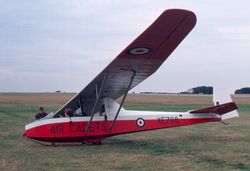
The ATC is proud that it was once the world's biggest soaring organisation, which is encouraging, considering the Bulldog engine. The ATC has not had any working gliders in generations; however, it has several families of non-working gliders, including the Slingsby type 21 and the Vigilant T1.
- Slingsby type 21
The Slingsby type 21 was the ATC's signature "flying bathtub" for many years. It was a two-seat open-cockpit glider: one seat for the cadet, one seat for the instructor, and one stick to control it. There are few instruments, no in-flight meals, and most regrettably, no toilets. The instructor is the one wearing a parachute and holding the shortest straw.
Being an ancient wooden and fabric glider, the Slingsby is extremely light and as aerodynamic as a camper van, giving it the flying characteristics of a barn door in a hurricane. The 21 is launched by winch, as the only aircraft powerful enough to drag such a slab up to the 30-knot flying speed would be a jet, whose wake would disrobe the 21's fabric wings and might make inroads on the frame, possibly sucking out the pilot's false teeth at the same time.
Winch launches are slightly more dangerous than the glider itself. On the call of "all out" that ensures that both are in, the glider lurches forward, as slack is taken up — probably breaking the wrist of the cadet tasked with holding the wing off the grass — then it stops, and the now-unattended wing drops to the grass, just as several tons of tension comes onto the wire. With one wing dragging, the glider is then accelerated in two seconds to 60 knots, lurching to the side the wing is down, then the other way as the panicky pilot over-corrects. Lifting off the ground half a second later, the T1 immediately pitches to 50 degrees nose-up. For the next fifteen seconds, the pilot just sits there, praying the cable will not snap, and praying even harder the cable will release at the top of the climb, preventing the glider and its crew being towed back to earth, wrapped around the powerful winch drum, and smothered in cable.
Glider pilots stay aloft for longer periods than the force of gravity allows through the use of thermals, which cadets obtain from damart.co.uk or mail-order from Minnesota. They can also use the up-thrust of air along a ridge, providing the ancient pilot still has enough faculties to react to the odd gust with a course change other than into the trees and dog-walkers at the summit.
- Vigilant T1
The Grob G109B, or Vigilant T1, is a bigger death trap than the Slingsby. It provides the worst of both worlds, as it is a glider with an engine and propeller. Technically, it can launch itself like a normal powered aeroplane, but the CAA insist on a limited power output, to qualify it as a "powered glider" (or in reality, a dangerously under-powered aircraft that can be flown solo by an overconfident 14-year-old after one grueling hour training on FSX) rather than a light aircraft. The Grob G109B provides the cadet the thrill of being "shot down", as the engine briefly misfires while struggling with the ascent, causing the thing to stall instantly and fall out of the sky.
With an un-aerodynamic side-by-side cockpit arrangement, a large engine and great big prop out front, the Grob G109B is also a terrible glider. Despite going against the grain, glider pilots would never voluntarily shut off the engine in flight, as its glide ratio is comparable to a breeze block. As a rule of thumb, if you can see the airfield over the nose, you are too far away to return to it. It is no wonder that the Vigilant 1 was marketed in America as the Catch-22.
Safeguards
As well as the fine state of the aircraft, all cadet climbing is supervised by professionally qualified instructors and covered by full insurance providing the following benefits in the rare case of mishap:
| Category of mishap | Benefit |
|---|---|
| Loss of limb | £ 5,000 |
| Loss of sight | £ 6,000 |
| Paralysis from the waist down | £10,000 |
| Paralysis from the neck down | £20,000 |
| Paralysis from the neck up | Promotion 1 rank |
Recognition of excellence
There are three levels which, when successfully completed, lead to a Bronze, Silver or Gold awards.
- Volunteering – Get involved providing services to individuals or the community. See above, under parking cars.
- Physical – Being active and improving skills and fitness in sport, dance, or through fighting in the car park behind the pub.
- Skills – Finding new interests and acquiring new talents (or perfecting existing ones) (or identifying the Commanding Officer's interests and doing the scut work to make them a reality).
- Expedition – Planning, training for, and completing an adventurous journey in the UK or abroad.
- Duke of Edinburgh’s Gold Award – For gaffes that match that of Prince Phillip. This requires a level of insensitivity way beyond that of an ordinary mortal.
See also
| Featured version: 9 May 2017 | |
| This article has been featured on the main page. — You can vote for or nominate your favourite articles at Uncyclopedia:VFH. | |
